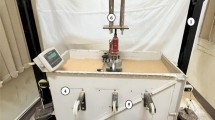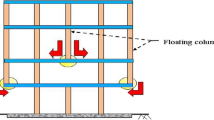Abstract
Due to their simplicity, analytical approaches based on the limit equilibrium approach have been used in the design of sheet pile walls for many years. However, due to a lack of understanding of the elastic behavior of the sheet pile wall and stress concentrations, some overestimations in values of maximum bending moment and anchor force may occur. These shortcomings have let an increment in the use of numerical models. In the present study, excavation work in the sand that has various fiction angles to be supported by a single anchored sheet pile wall was solved considering the ground water level and varying the anchor level from the soil surface. The effects of the solution method, soil friction angle, and anchor level on the embedment depth, anchor force, and maximum bending moment for sheet pile design are investigated using the free earth support and fixed earth support methods as analytical methods and the finite element method (FEM) as a numerical method. The Matlab R2015a program is used to execute analytical solution methods, while PLAXIS 2D V8.2 is used to do finite element (FE) analysis. The findings of embedment depth, anchor force, and maximum bending moment versus anchor level and friction angle of soil, ∅, are presented, illustrated, and discussed, in detail. As a consequence of the study, it is observed that the solution method, friction angle of soil, and anchor level have a significant effect on the design of the single anchored sheet pile wall and that the results of the fixed earth support method correlate better with the results of the FEM in comparison to the free earth support method.

















Similar content being viewed by others
Abbreviations
- FEM:
-
Finite element method
- FE:
-
Finite element
- ANL-1:
-
Fixed support method analysis
- ANL-2:
-
Free support method analysis
- FEM-1:
-
Finite element method analysis of fixed earth support method models
- FEM-2:
-
Finite element method analysis of free earth support method models
- EA:
-
Axial stiffness
- EI:
-
Bending stiffness
- ∅:
-
Internal friction angle of soil
- γd :
-
Dry unit weight of soil
- γs :
-
Specific gravity of soil particles
- γw :
-
Unit weight of water
- γ′:
-
Effective unit weight of soil
- c:
-
Cohesion
- Ka:
-
Active soil pressure coefficient
- Kp:
-
Passive soil pressure coefficient
- K0 :
-
The coefficient of lateral earth pressure at rest
- P’A :
-
The lateral active earth force
- P’P :
-
The lateral passive earth force
- Ap:
-
Anchor force
- Rb :
-
Reaction force occurring in joint
- Mmax:
-
The maximum moment occurs in the cross-section of the sheet pile
- GWL:
-
Groundwater level
- L1 :
-
Groundwater level distance from the soil surface
- L2 :
-
The distance between the GWL and dredge line
- l1 :
-
Anchor level from the soil surface
- H:
-
Excavation depth
- D:
-
Embedment depth
- y:
-
The distance from the dredge level to the contra flexure point
- x:
-
The distance from GWL to the level where shear force is zero
References
Al-habib AAM (2012) Interaction between sheet pile wall and stabilized backfill material. Lulea University of Technology, Lulea, Sweden
Alimirzaei S, Mohammadimehr M, Tounsi A (2019) Nonlinear analysis of viscoelastic micro-composite beam with geometrical imperfection using FEM: MSGT electro-magneto-elastic bending, buckling and vibration solutions. Struct Eng Mech 71:485–502. https://doi.org/10.12989/sem.2019.71.5.485
Altun G (2013) Ankrajlı ve ankrajsız derin kazı iksa sistemlerinin sayısal yöntemler ile analizi. Eskişehir Osmangazi Üniversity, Eskişehir, Turkey
Andresen L (2006) Parametric FE study of loads and displacements of braced excavations in soft clay. In: Numerical Methods in Geotechnical Engineering. Taylor & Francis, London, pp 399–403
Babu GLS, Basha BM (2008) Optimum design of cantilever sheet pile walls in sandy soils using inverse reliability approach. Comput Geotech 35:134–143. https://doi.org/10.1016/j.compgeo.2007.04.001
Bilgin Ö (2012) Lateral earth pressure coefficients for anchored sheet pile walls. Int J Geomech 12:584–595. https://doi.org/10.1061/(ASCE)GM.1943-5622.0000154
Bjerrum L, Clausen C, Duncan JM (1972) Earth pressures on flexible structures: a state of the art report. In: 5th European Conf. on Soil Mechanics and Foundation Engineerin. Norges Geotekniske Institutt, Oslo, Norway
Blum H (1931) Einspannungsverhältnisse bei Bohlwerken. Ernst & Sohn, Berlin, Germany
Bowles J (1996) Foundation analysis and design, 5th edn. McGraw- Hill International Editions, New York, NY, USA
Brinkgreve R, Engin E, Swolfs W et al (2010) PLAXIS 2D:2010
Coulomb CA (1776) Essias sur une application des maximis et minimis a quelques problems de statique relatits a larchitecture. Mémoires l’Académie R des Sci Present par Divers 5
Das BM (2011) Principles of Foundation Engineering, 7th edn. Cengage Learning, Stamford, CT, USA
Das MR, Das SK (2015) Optimal design of sheet pile wall embedded in clay. Inst Eng 96:249–258. https://doi.org/10.1007/s40030-015-0128-9
Day RA, Potts DM (1993) Modelling sheet pile retaining walls. Comput Geotech 15:125–143. https://doi.org/10.1016/0266-352X(93)90009-V
Dezvareh R (2020) Upgrading the seismic capacity of pile-supported wharfs using semi-active liquid column gas damper. J Appl Comput Mech 6:112–124. https://doi.org/10.22055/JACM.2019.28242.1466
Emarah DA, Seleem SA (2018) A numerical study of anchored sheet piles subjected to different types of sandy soils backfill. HBRC J 14:422–430. https://doi.org/10.1016/j.hbrcj.2018.03.001
Grande L, Soreide OK, Tefera TH (2002) Large scale model testing on the moment distribution and deformation behaviour of a sheet pile wall. In: 2nd Int. Conf. on Soil Structure Interaction in Urban Civil Engineering. Swill Federal Institute of Technology, Zurich, Switzerland
GuhaRay A, Baidya DK (2015) Reliability-based analysis of cantilever sheet pile walls backfilled with different soil types using the finite-element approach. Int J Geomech 15:06015001. https://doi.org/10.1061/(ASCE)GM.1943-5622.0000475
Hashash YMA, Marulanda C, Ghaboussi J, Jung S (2006) Novel approach to integration of numerical modeling and field observations for deep excavations. J Geotech Geoenviron Eng 132:1019–1031. https://doi.org/10.1061/(ASCE)1090-0241(2006)132:8(1019)
Hirane H, Belarbi MO, Houari MSA, Tounsi A (2021) On the layerwise finite element formulation for static and free vibration analysis of functionally graded sandwich plates. Eng Comput 1:1–29. https://doi.org/10.1007/s00366-020-01250-1
Jiang J, Zhao Q, Zhu S, Zhang W (2021) New procedure for active earth pressure calculation in cohesive-frictional soil. Arab J Geosci 14:1062. https://doi.org/10.1007/s12517-021-07381-z
Jiang S, Du C, Sun L (2018) Numerical analysis of sheet pile wall structure considering soil-structure interaction. Geomech Eng 16:309–320. https://doi.org/10.12989/gae.2018.16.3.309
King GJW (1995) Analysis of cantilever sheet-pile walls in cohesionless soil. J Geotech Geoenviron Eng 121:629–635
Krabbenhoft K, Damkilde L, Krabbenhoft S (2005) Ultimate limit state design of sheet pile walls by finite elements and nonlinear programming. Comput Struct 83:383–393. https://doi.org/10.1016/j.compstruc.2004.08.016
Kumar Y, Gupta A, Tounsi A (2021) Size-dependent vibration response of porous graded nanostructure with FEM and nonlocal continuum model. Adv Nano Res 11:1–17. https://doi.org/10.12989/anr.2021.11.1.001
Linh NN, Nguyen NA, Van Nguyen K, Nguyen DD (2021) Weighted dual approach to an equivalent stiffness-based load transfer model for jacked open-ended pile. J Appl Comput Mech 7:1751–1763. https://doi.org/10.22055/JACM.2021.37430.3013
Lopez S, Sanhueza C, Gandia C (2017) Anchored piles deep excavations: a case study. In: 16th World Conference on Earthquake. Santiago, Chile
Mensah D (2014) Comparison of numerical and classical analytical method for sheet pile wall analyses. Complutense University of Madrid, Madrid, Spain
Nataraj MS, Hoadley PG (1984) Design of anchored bulkheads in sands. J Geotech Eng 110:505–515
Padfield C, Mair R (1984) Design of retaining walls embedded in stiff clay. Construction Industry Research & Information Assoc, London, UK
Potts DM, Fourie AB (1985) The effect of wall stiffness on the behavior of a propped retaining wall. Geotechnique 35:347–352. https://doi.org/10.1680/geot.1985.35.3.347
Rankine WJ (1857) No title. Philos Trans R Soc Lond A 147:9–27
Rowe PW (1952) Anchored sheet-pile walls. Proc Inst Civ Eng 1:27–70. https://doi.org/10.1680/iicep.1952.10942
Schanz T, Vermeer PA, Bonnier PG (2019) The hardening soil model: Formulation and verification. In: Beyond 2000 in Computational Geotechnics. Routledge, Amsterdam, Netherlands, pp 281–296
Singh AP, Chatterjee K (2020) Influence of soil type on static response of cantilever sheet pile walls under surcharge loading: a numerical study. Arab J Geosci 13:138. https://doi.org/10.1007/s12517-020-5170-x
Sitharam TG (2017) Advanced foundation engineering, 1st edn. CRC Press, Bargalorei, India
Skrabl S (2006) Interactional approach of cantilever pile walls analysis. ACTA Geotech Slov 3:46–59
Smith GN, Smith IGN (1998) Elements of soil mechanics, 7th edn. Blackwell Science, London, UK
Tan Y, Paikowsky SG (2008) Performance of sheet pile wall in peat. J Geotech Geoenviron Eng 134:445–458. https://doi.org/10.1061/(ASCE)1090-0241(2008)134:4(445)
Tang L, Cong S, Xing W, Ling X, Geng L, Nie Z, Gan F (2018) Finite element analysis of lateral earth pressure on sheet pile walls. Eng Geol 244:146–158. https://doi.org/10.1016/j.enggeo.2018.07.030
Torrabadella AG (2013) Numerical analysis of cantilever and anchored sheet pile walls at failures and comparison with classical methods. Escola de Camins, Barcelona, Spain
U.S. Army Corps of Engineers (1996) USACE , Design of sheet pile walls. American Society of Civil Engineers (ASCE), New York, USA
Yaylaci MM (2020) Finite element modeling of contact between an elastic layer and two elastic quarter planes. Comput Concr 26:107–114. https://doi.org/10.12989/CAC.2020.26.2.107
Zahmatkesh A, Choobbasti AJ (2015) Evaluation of wall deflections and ground surface settlements in deep excavations. Arab J Geosci 8:3055–3063. https://doi.org/10.1007/s12517-014-1419-6
Zheng D-F, Nian T-K, Liu B, Yin P, Song L (2015) Coefficient charts for active earth pressures under combined loadings. Geomech Eng 8:461–476. https://doi.org/10.12989/gae.2015.8.3.461
Author information
Authors and Affiliations
Corresponding author
Additional information
Responsible Editor: Zeynal Abiddin Erguler
Rights and permissions
About this article
Cite this article
Akan, R. Examination of the behavior of the single anchored sheet piles in sand utilizing analytical and numerical methods. Arab J Geosci 14, 1949 (2021). https://doi.org/10.1007/s12517-021-08347-x
Received:
Accepted:
Published:
DOI: https://doi.org/10.1007/s12517-021-08347-x




